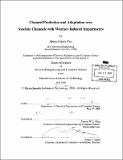| dc.contributor.advisor | Vincent W.S. Chan. | en_US |
| dc.contributor.author | Choi, Jihwan Patrick, 1975- | en_US |
| dc.contributor.other | Massachusetts Institute of Technology. Dept. of Electrical Engineering and Computer Science. | en_US |
| dc.date.accessioned | 2005-08-24T19:26:03Z | |
| dc.date.available | 2005-08-24T19:26:03Z | |
| dc.date.copyright | 2000 | en_US |
| dc.date.issued | 2000 | en_US |
| dc.identifier.uri | http://hdl.handle.net/1721.1/9070 | |
| dc.description | Thesis (S.M.)--Massachusetts Institute of Technology, Dept. of Electrical Engineering and Computer Science, 2000. | en_US |
| dc.description | Includes bibliographical references (leaves 85-87). | en_US |
| dc.description | Title as it appears in MIT commencement exercises program, June 2000: Satellite channels with weather-induced impairments. | en_US |
| dc.description.abstract | Bad weather conditions, especially due to rain, cause satellites operating at high frequencies (above 10 GHz) to have significant link attenuation. Usually extra link margins are used to assure link availability. These margins cause inefficient use of precious satellite and terminal power, and unnecessarily limit data throughputs. Efficiency improvements using channel prediction and adaptation over satellite channels with weather-induced impairments are considered in this thesis. First, we consider scintillation and rain attenuation as two dominant factors for signal fading over satellite-earth paths above 10 GHz, and explore physical and mathematical modeling of the two processes. Statistical and spectral analyses of these processes using one or two pole autoregressive (AR) models yield simple linear estimators for the received signal attenuation. Using these estimators, we present results where we can predict the received signal attenuation within ±0.5 dB 1 second ahead and within ± 1.0 dB 4 seconds ahead. For adaptation, we change the signal transmission power, the modulation symbol size, and the code rate adaptively. In particular, we suggest a continuous power control and discrete rate control strategy, through which we build a set of modulation/code states, and discretely change the modulation symbol size and the code rate from state to state. Within each state, continuous power control is implemented. Several examples that use this technique and quantitative analyses of power increase and capacity are provided. The analyses indicate that there is a substantial gain in performance either in capacity and/or power consumption with the adaptive schemes. | en_US |
| dc.description.statementofresponsibility | by Jihwan Patrick Choi. | en_US |
| dc.format.extent | 87 leaves | en_US |
| dc.format.extent | 3957660 bytes | |
| dc.format.extent | 3957419 bytes | |
| dc.format.mimetype | application/pdf | |
| dc.format.mimetype | application/pdf | |
| dc.language.iso | eng | en_US |
| dc.publisher | Massachusetts Institute of Technology | en_US |
| dc.rights | M.I.T. theses are protected by copyright. They may be viewed from this source for any purpose, but reproduction or distribution in any format is prohibited without written permission. See provided URL for inquiries about permission. | en_US |
| dc.rights.uri | http://dspace.mit.edu/handle/1721.1/7582 | |
| dc.subject | Electrical Engineering and Computer Science. | en_US |
| dc.title | Channel prediction and adaptation over satellite channels with weather-induced impairments | en_US |
| dc.title.alternative | Satellite channels with weather-induced impairments | en_US |
| dc.type | Thesis | en_US |
| dc.description.degree | S.M. | en_US |
| dc.contributor.department | Massachusetts Institute of Technology. Department of Electrical Engineering and Computer Science | |
| dc.identifier.oclc | 46816229 | en_US |
